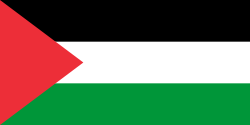| Demographics of the State of Palestine | |
|---|---|
 Population pyramid of the State of Palestine in 2020 | |
| Population |
|
| Growth rate |
|
| Birth rate |
|
| Death rate |
|
| Language | |
| Spoken | Arabic, Hebrew (by Israeli settlers and many Palestinians) |
Demographic features of the population of the area commonly described as the Palestinian territories includes information on ethnicity, education level, health of the populace, economic status, religious affiliations and other aspects of that population.
Contents
- Overview
- Population size and structure
- Age structure
- Vital statistics
- UN estimates 2
- Registered births and deaths
- Life expectancy
- Demographics of the Gaza Strip
- Population
- Age structure 2
- Ethnic groups
- Religions
- Languages
- Demographics of the West Bank
- Population 2
- Ethnic groups 2
- Religions 2
- Languages 2
- See also
- Notes
- References
- External links
| Part of a series on |
| Palestinians |
|---|
 |
| Demographics |
| Politics |
|
| Religion /religious sites |
| Culture |
| List of Palestinians |
According to a commonly used definition as relating to an application of the 1949 Armistice Agreement green line, the Palestinian territories have contributory parts of the Gaza Strip and the West Bank (including East Jerusalem).
The Palestinian National Authority, the United Nations Security Council, [1] the United Nations General Assembly, [2] the European Union, [3] the International Court of Justice, [4] and the International Committee of the Red Cross [5] use the terminology "Palestinian territories" or "occupied Palestinian territories". Israel refers to the administrative division encompassing Israeli-controlled Jewish-majority civilian areas of Area C of the West Bank, excluding East Jerusalem, as the Judea and Samaria Area (Hebrew : אֵזוֹר יְהוּדָה וְשׁוֹמְרוֹן, Ezor Yehuda VeShomron). [6]



